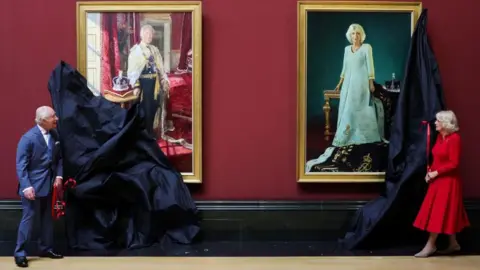In a momentous occasion that commemorated the second anniversary of their coronation, King Charles III and Queen Camilla unveiled their newly commissioned state portraits at the National Gallery. This unveiling took place in a setting that celebrated royal heritage and artistry, with a splendor befitting the significance of the event. The portraits are set to be displayed in the Gallery’s Central Hall, providing visitors an opportunity to admire them before they move to their permanent home at Buckingham Palace, where they are expected to be exhibited starting in June.
The portraits themselves represent more than just artistic endeavors; they encapsulate elements of royal decorum and tradition. King Charles is depicted in his regal Robe of State and naval uniform adorned with medals, signifying his roles and achievements. In contrast, Queen Camilla graces her portrait in the ceremonial dress she wore during the coronation. The moment was particularly heartwarming, drawing applause from the audience at the Gallery as the couple removed the coverings, an act that symbolized revealing both art and history to the public.
Both portraits were crafted by renowned artists. King Charles was painted by Peter Kuhfeld, an artist who has known the King for over four decades. This long-standing relationship likely contributed to the depth and authenticity of the finalized portrait, which reflects Charles’ dignified personality and history. The Queen’s portrait, on the other hand, was created by Paul S. Benney, who shared insights about his time working with the Queen, noting that their sittings were relaxed and filled with laughter and interesting conversation.
The King’s portrait captures him adorned in the Robe of State he wore during the first part of the coronation ceremony, alongside the ceremonial Imperial State Crown, a significant artifact in royal tradition. Queen Camilla’s accompanying robe and crown in her portrait are reminiscent of her exit from Westminster Abbey on coronation day, symbolizing her transition into royal life.
Both artists recounted their experiences during the painting process. Kuhfeld described the several sittings held at St. James’s Palace, during which he aimed to convey the King’s character in his work. He emphasized the King’s understanding of artistic processes, noting that Charles is approachable and thoughtful about the artistic representation of himself. Meanwhile, Benney enjoyed a more informal working relationship with Queen Camilla, who allowed him into her casual space at Clarence House, fostering an environment conducive to creativity and intimacy.
The public’s expectation and curiosity regarding the royals’ reception of the portraits were evident, and both King Charles and Queen Camilla responded positively upon viewing their likenesses. Kuhfeld, aware of the delicate nature of a sitter’s opinion on their own image, humorously noted that it’s often best to avoid asking them what they think. However, Benney shared that the Queen expressed her delight about her portrait, stating, “I think it’s really lovely.” Additionally, family support played a role in the unveiling; the Queen’s daughter, Laura Lopes, was present and echoed her approval of the portrait, which Benney appreciated as a significant affirmation of his work.
In conclusion, the unveiling of the state portraits of King Charles III and Queen Camilla not only marks a significant artistic achievement but also reinforces the connection between the royal family and the art community. These portraits, meticulously constructed and filled with personal nuances, are sure to serve as evocative reminders of a pivotal moment in British history, capturing the essence of the modern monarchy. As they prepare to grace the walls of Buckingham Palace, they will undoubtedly continue to inspire both admiration and scholarly discourse for years to come.



